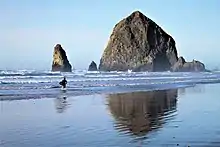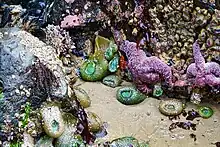Haystack Rock | |
|---|---|
 Haystack Rock and the Needles, Cannon Beach 2023 | |
| Coordinates: 45°53′4″N 123°58′5″W / 45.88444°N 123.96806°W | |
| Location | Oregon |
| Offshore water bodies | Pacific Ocean |
| Age | 15-16 million years |
| Formed by | Lava flows and erosion |
| Operator | Various state and federal departments |
| Elevation | 235 feet (72 m) |
Haystack Rock is a 235 ft-tall (72 m) sea stack in Cannon Beach, Oregon. It is the third-tallest such intertidal structure in the world. A popular tourist destination on the Oregon Coast, the monolithic rock is adjacent to the beach and accessible by foot at low tide. The Haystack Rock tide pools are home to many intertidal animals, including starfish, sea anemone, crabs, chitons, limpets, and sea slugs. The rock is also a nesting site for many sea birds, including terns and puffins.
History
In 1990, Haystack Rock was granted Marine Garden status by the Oregon Department of Fish and Wildlife. The site is protected under the Oregon Islands National Wildlife Refuge as a designated wilderness area.[1]
The sea stack formation was closed temporarily during July 2023 after a cougar was documented, for the first time, climbing on the rock in search of prey.[2]
Location and management
Haystack Rock is located about 1.5 miles (2.4 km) south of downtown Cannon Beach in Clatsop County and about 80 miles (129 km) west of Portland. The nearest major road is U.S. Route 101. Haystack Rock is part of the Tolovana Beach State Recreation Site.
The area below the mean high water (MHW) level is managed by Oregon Parks and Recreation. The area above the MHW level is managed by the Oregon Islands National Wildlife Refuge of the United States Fish and Wildlife Service.[2]
Geology

Measuring 235 feet (72 m) tall,[1] Haystack Rock is composed of basalt and was formed by lava flows emanating from the Blue Mountains and Columbia basin about 15-16 million years ago. The lava flows created many of the Oregon coast's natural features, including Tillamook Head, Arch Cape, and Saddle Mountain. Haystack Rock was once joined to the coastline but years of erosion have since separated the monolith from the coast. Three smaller, adjacent rock formations to the south of Haystack Rock are collectively called "The Needles".
Ecology
Collecting plants or animals is strictly prohibited and to protect nesting birds, climbing above the mean high tide level barnacle line is not allowed.[2] The Haystack Rock Awareness Program is run by the City of Cannon Beach and conducts educational seminars at the rock during low tide between February and October.
A variety of bird species, such as pigeon guillemots, common murres, black oystercatchers, and tufted puffins, roost and nest on the rock, raising their young usually between March and September.[2]
Recreation

Visitors to Haystack Rock can view many species of marine wildlife in their natural habitat during low tide. The thin strip of rock and sand that connects it to the beach at these times features many tide pools. The area surrounding the rock is popular for picnicking, kite-flying, and bird-watching. As of 2023, the rock averages an annual count of 350,000 visitors.[1]
Haystack Rock is one of the most identifiable geological formations of Oregon. Many people each year become temporarily trapped on Haystack Rock when high tide engulfs the rock in water, necessitating rescue by the United States Coast Guard or local authorities. Oregon's beaches are publicly owned, and there are several hotels along the beachfront within walking distance of Haystack Rock, making the area congested with tourists during the summer.
Popular culture
- Haystack Rock can be seen prominently in the 1971 film of Oregonian Ken Kesey's novel Sometimes a Great Notion during the scene where the Stampers brawl with the union workers.
- Haystack Rock can be seen in the background of the opening scene of The Goonies, when the Fratellis are fleeing from the police and then enter a race on the beach. Later in the film Haystack Rock is seen again when Mikey is pointing out some rocks in the distance.
- Haystack Rock can be seen in the 1979 movie 1941 directed by Steven Spielberg. The rock is particularly out of place, as the setting is supposed to be the California coast.
- Haystack Rock can be seen in the movie Kindergarten Cop, during the carnival scene late in the movie.
- In the novel The Cabin at the End of the World by Paul G. Tremblay, Haystack Rock is submerged by a tsunami triggered by an earthquake off the coast of Oregon.
- In Louis Theroux's documentary Altered States: Choosing Death, Haystack Rock can be seen during an interview with a woman whose home overlooks the sea stack.
Gallery
 |  |  |
 |  |  |
 |  |
 Haystack Rock northwest face |  Haystack Rock from Hwy 101 pullout south of Cannon Beach |  Haystacks Rocks and the Needles,Cannon Beach just before sunset 2023 |
References
- 1 2 3 KGW staff (July 17, 2023). "Haystack Rock area reopens after cougar departs from Oregon coast landmark". KING 5 News (Seattle, Washington). Retrieved August 14, 2023.
- 1 2 3 4 "Cougar that closed Oregon's Cannon Beach moves on". NBC News. The Associated Press. July 17, 2023. Retrieved August 14, 2023.
External links
- Cannon Beach Haystack Rock Rocky Shore Management Cell from the Oregon Ocean-Coastal Management Program
- Friends of Haystack Rock
- Oregon Islands National Wildlife Refuge
- Tolovana Beach State Recreation Site
- "A 1940 Oregon Coast Tour: Seaside to Bay City" from the Oregon State Archives